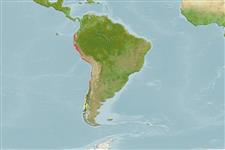Elasmobranchii (tubarões e raias) (sharks and rays) >
Carcharhiniformes (Ground sharks) >
Triakidae (Houndsharks) > Triakinae
Etymology: Mustelus: Latin for weasel, an ancient name for sharks, possibly referring to the pointed snouts, swift movements and/or rapacious feeding behavior of smaller predatory sharks [strictly not tautonymous with Squalus mustelus Linnaeus 1758 since type was designated by the ICZN] (See ETYFish); whitneyi: In honor of American fisheries biologist Richard R. Whitney (1927-2011), for his teachings and guidance during the author’s study of sharks (See ETYFish).
Eponymy: Dr Richard R Whitney (1927–2011) was a fisheries biologist. [...] (Ref. 128868), visit book page.
Environment: milieu / climate zone / depth range / distribution range
Ecologia
marinhas demersal; intervalo de profundidade 16 - 211 m, usually 70 - 100 m (Ref. 9253). Tropical; 1°N - 45°S, 83°W - 70°W
Southeast Pacific: Ecuador to southern Chile.
Tamanho / Peso / Idade
Maturity: Lm ? range ? - ? cm
Max length : 87.0 cm TL (female)
An offshore bottom-dwelling shark found on the continental shelf. Prefers rocky bottom around islands. Feeds on crabs, mantis shrimp, and small bony fishes. Viviparous, with 5 to 10 young per litter. Size at birth about 25 cm.
Life cycle and mating behavior
Maturidade | Reprodução | Desova | Ovos | Fecundidade | Larvas
Viviparous (Ref. 244). Distinct pairing with embrace (Ref. 205).
Compagno, L.J.V., 1984. FAO Species Catalogue. Vol. 4. Sharks of the world. An annotated and illustrated catalogue of shark species known to date. Part 2 - Carcharhiniformes. FAO Fish. Synop. 125(4/2):251-655. Rome: FAO. (Ref. 244)
Categoria na Lista Vermelha da IUCN (Ref. 130435: Version 2024-1)
Ameaça para o homem
Harmless
Utilização humana
Pescarias: altamente comercial; peixe desportivo: sim
Ferramentas
Relatórios especiais
Descarregue XML
Fontes da internet
Estimates based on models
Preferred temperature (Ref.
123201): 12.6 - 15.6, mean 15 °C (based on 15 cells).
Phylogenetic diversity index (Ref.
82804): PD
50 = 0.5000 [Uniqueness, from 0.5 = low to 2.0 = high].
Bayesian length-weight: a=0.00224 (0.00104 - 0.00482), b=3.14 (2.97 - 3.31), in cm total length, based on LWR estimates for this Genus-body shape (Ref.
93245).
Nível Trófico (Ref.
69278): 3.7 ±0.0 se; based on diet studies.
Resiliência (Ref.
120179): Muito baixo, tempo mínimo de duplicação da população maior que 14 anos (Fec=4).
Fishing Vulnerability (Ref.
59153): Moderate to high vulnerability (55 of 100).
Nutrients (Ref.
124155): Calcium = 33.5 [9.6, 163.5] mg/100g; Iron = 0.511 [0.154, 1.840] mg/100g; Protein = 21 [19, 23] %; Omega3 = 0.0958 [, ] g/100g; Selenium = 83 [22, 289] μg/100g; VitaminA = 13.1 [5.0, 32.5] μg/100g; Zinc = 0.954 [0.422, 1.897] mg/100g (wet weight);
